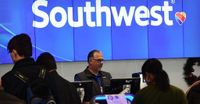As the summer of 2025 draws to a close, air travelers across the globe are facing a turbulent landscape of shifting schedules, spiking fares, and route cancellations. From the United States to the United Arab Emirates, airlines are recalibrating their operations in response to unpredictable demand, economic headwinds, and the perennial challenges of peak travel periods. The result? For many, the once straightforward task of booking a summer flight has become a high-stakes game of timing and flexibility.
According to recent reporting by CNN and First Alert 4, U.S. airlines have been forced to rethink their August schedules, with many carriers drawing down capacity in response to changing travel patterns. The days when airlines could count on a guaranteed windfall in the third quarter are gone—now, planners must be "surgical" with their schedules, as described by multiple airline executives. "It really was, I would say, middle of May, when we started seeing Memorial Day bookings pick up," JetBlue Airways President Marty St. George told investors last month. "We had a fantastic Memorial Day, much better than forecast, and that really carried into June. But it does have the feeling of people just waited a long time to make the final decisions."
This newfound unpredictability is not just a matter of traveler whim. The economic backdrop has played a starring role in shaping airline strategies for 2025. The on-again, off-again tariffs under President Donald Trump and general economic uncertainty earlier this year led to a slump in consumer confidence. Airlines, expecting a blockbuster summer, instead found themselves slashing prices—sometimes even during the traditional peaks of June and July—to fill seats. According to CNN, this overcapacity drove fares down, impacting profitability across the board. Even as demand improved in recent months, major U.S. carriers like Delta, American, United, and Southwest all lowered their profit forecasts for the year as of mid-2025.
But as airlines trimmed their schedules to adapt, the pendulum swung the other way. U.S. airlines' domestic capacity dropped by 6% from July to August 2025, a sharper decline than the 4% cut seen in the same period last year, according to aviation data firm Cirium. For comparison, the cut between July and August in 2019 was just 1.7%. These reductions, coupled with rising operational costs, have begun to push fares up again. Airfares rose 0.7% in July 2025 compared to the same month in 2024, with a seasonally adjusted 4% jump from June to July.
Airlines are also grappling with the shifting sands of the academic calendar. Schools in Dallas and Fort Worth, Texas, returned as early as August 5, while Atlanta public schools resumed on August 4. In 2023, more than half of U.S. public school students were back in classrooms by mid-August, a trend that has only accelerated. Southwest, with its Texas roots, ended its summer schedule on August 5 this year—ten days earlier than in 2023. American Airlines is planning to shift its summer schedule change to the week before Memorial Day starting in 2026, in direct response to schools letting out earlier.
"We're moving our whole summer schedule change to the week before Memorial Day," said Brian Znotins, American Airlines' vice president of network planning and schedule, in an interview with CNBC. "That's just in response to schools letting out in the spring." Znotins also highlighted the challenge of balancing capacity: "When demand is lower, you need to find ways to attract customers to your flights with a good quality schedule and product changes."
Yet the pain isn’t just in scheduling. For some travelers, especially those flying out of St. Louis, the impact is much more concrete. According to First Alert 4, Southwest Airlines announced the cancellation of multiple direct flights from St. Louis Lambert Airport to destinations including Little Rock, Tulsa, Charlotte, Des Moines, Oklahoma City, and Wichita. These cuts will leave Lambert with 71 nonstop markets, 60 of which are still operated by Southwest. The ripple effect is substantial: an estimated 860,000 annual passengers will be affected, based on Department of Transportation data. Passenger counts on the canceled routes include 142,530 from Little Rock, 186,155 from Des Moines, and 165,128 from Oklahoma City, among others.
The reaction from the public has been swift and pointed. “How is that going to make anything better?” St. Louis resident Beth Huffman asked. “To me, they’re going to lose business.” Another passenger, Curtis Howard, lamented, “If you’re cutting stuff down, you’re cutting employment, you’re cutting travel — you’re cutting more and more. Grow it, make it bigger.”
Lambert officials, while expressing disappointment, acknowledged their ongoing partnership with Southwest. For its part, the airline told First Alert 4, “Through our March 2026 schedule that was released today, we’ll offer up to 110 departures at St. Louis Lambert International Airport, providing unmatched point-to-point service for local Customers and strong north-south connectivity to the vast Southwest network. We are fully committed to the Gateway City and look forward to serving our loyal Customers there for years to come.”
But for those who have lost their direct routes, the options are now limited—often requiring inconvenient connections or less desirable flight times. The broader industry trend is clear: airlines are paring back to focus on profitable routes, even if it means inconveniencing hundreds of thousands of passengers.
The story is similar abroad. In the United Arab Emirates, as schools prepare to reopen on August 25, 2025, inbound airfares have skyrocketed. According to Khaleej Times, the price of a return economy fare from London to Dubai with a connection jumped from Dh1,300 in July to a staggering Dh6,321 for travel between August 18 and 24. Direct flights from London to Dubai, which were previously available for Dh2,500 to Dh3,000, have also seen sharp increases. Flights from Mumbai now cost Dh1,600, up significantly from earlier in the summer.
The culprit is a familiar one: surging demand as expatriate families rush back ahead of the new school year, combined with limited seat availability. Dubai International Airport is bracing for a flood of over 3.6 million passengers between August 13 and 25, with daily averages reaching 280,000. Airport authorities have ramped up resources to manage the crowds, but for travelers caught in the last-minute rush, the window for affordable flights has all but closed.
Experts recommend booking well in advance to avoid the worst of the price spikes. As one travel agent noted, fares are expected to drop after the back-to-school rush tapers off in early September. For those who missed out, flexibility—whether in travel dates or in choosing alternative airports—can sometimes yield better deals. The late-summer fare surge, while dramatic, is a recurring feature of the global travel calendar, driven by the confluence of family travel, school schedules, and business demands.
For airlines, the challenge is ongoing: how to match capacity to demand in an era when both can shift at a moment’s notice. For travelers, the lesson is clear—plan ahead, stay flexible, and be prepared for surprises. As the industry continues to adapt, the only certainty is change.




